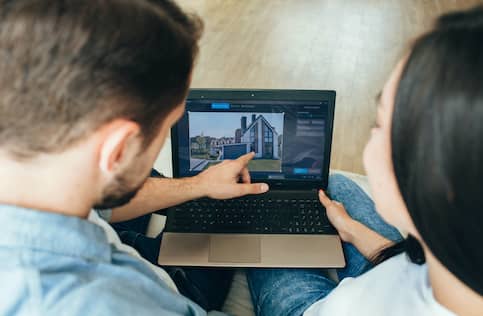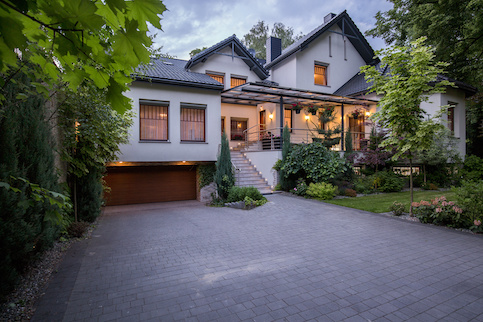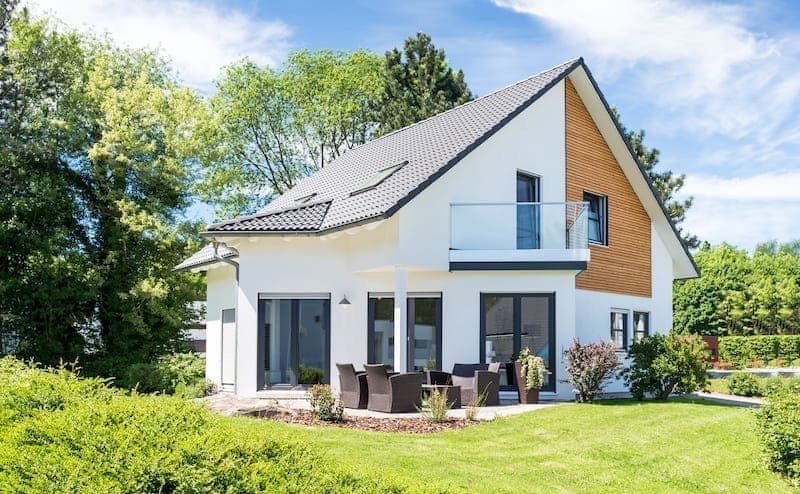Shopping for a new home to rent or buy can be overwhelming. Because buying a home is expensive and a long-term commitment, if you decide to buy, you’ll want to feel satisfied with your purchase.
In this article, we’ll talk about what to look for when buying a house and what you need to consider when evaluating the most important elements of a home.
See what you can afford.
Quicken Loans® can help you find a lender.
What To Look For When Buying A House
Choosing a home is a highly personal decision. As you think about the different aspects of a home, rank their level of importance to your needs and decide which are negotiable and which are deal breakers.
Below are the top 11 considerations you should take note of when viewing properties.
1. House Size
You should have a general idea of what size house you want before you even find a real estate agent and start going to open houses. Figure out a minimum and maximum square footage and the number of bedrooms and bathrooms you’ll need.
What size house you should buy will depend on your needs and your personal preferences. If you have a large family or plan on starting one soon, you’ll probably need to look at houses with more square footage and more bedrooms and bathrooms. On the other hand, if your household is just you or you and a partner, it may make more sense and be more affordable to look at smaller houses.
2. The Ideal Yard
Another matter of personal preference is what kind of yard you’d like. Do you want a lot of acreage and beautiful, low-maintenance landscaping? Or would you prefer to avoid the responsibility that comes with having a big lawn? Maybe you want a home that sits back further from the road, providing a little more privacy.
You’ll also have to think about what kind of features you want in the backyard. You can find homes with all sorts of natural and human-made features, from streams and ponds to pools, hot tubs, patios, swing sets, decks, built-in grills and more. For some home buyers, these are attractive and useful features, while for others, they signal liability, expense and a huge time commitment.
3. The Home’s Exterior
Your main line of defense against buying a home with a deteriorating exterior will be your home inspection, but it’s still a good idea to keep an eye out for red flags.
Here are some of the main exterior components you should be sure to check out when viewing a house:
- Roof: A new roof can cost $5,000 – $15,000 or more. It’s not an expense you want to be stuck with as a new home buyer. Look for damage and ask the current owners how old the roof is and how it’s been maintained.
- Foundation: Foundation problems can cost you thousands to tens of thousands of dollars to repair. To spot a bad foundation, keep an eye out for cracks in the walls (particularly around doorways or windows). Doors and windows that stick or jam are another warning sign. Ultimately, you’ll want to get a professional to sign off on the state of the home’s foundation.
- Siding: Check out the exterior walls for any obvious signs of damage or disrepair, including peeling paint, rotting wood, cracks or other signs of decay.
4. Number Of Bedrooms
Whether the home’s bedrooms are suitable for your needs will depend on how you plan to use them. For example, families with small children might not want a house where the primary bedroom is on a different floor from the kids’ bedrooms.
If you plan on converting an extra bedroom into a home office, you might prefer a floor plan where the bedrooms are farther away from the hustle and bustle of the kitchen and living room.
Again, the square footage and the number of bedrooms are important considerations. However, there are plenty of other factors to think about, including closet space, natural versus artificial light, views from the windows, general privacy and whether there’s a bathroom attached to the primary bedroom.
5. Bathrooms
When you’re checking out the bathroom, make sure everything’s in working order:
- With the seller’s or REALTOR®’s permission, flush the toilets, test the faucets and even turn on the shower.
- Make sure the fan works.
- Look under the sink and around the toilet for leaks and water damage.
- Keep an eye out for mold.
If you’re seriously considering buying a house, you’ll want to make sure there are no surprises after you move in, such as low water pressure or plumbing problems.
Make a note of what type of shower or tub each bathroom has and if they suit your needs. Bathroom renovations can be costly, so make sure you’re either happy with the bathrooms as-is or prepared to pay for improvements down the line.
Find A Mortgage Today and Lock In Your Rate!
Get matched with a lender that will work for your financial situation.
6. Living Room
What are you looking for in your new home’s living room? Do you want it to feel cozy and warm or chic and modern?
Style is important but can often be altered. So, focus on the basic floor plan and square footage of the room. Can you see your family members relaxing in this space? If you’re a first-time home buyer and this is a starter home, does it work for your needs right now versus down the line?
Consider the layout of the room as well as how your furniture might fit. Does the room design limit your choices in ways that can make the space feel smaller or leave certain areas unusable? Is the room large enough for all your family members’ needs?
Don’t forget to consider the type of floor. Carpets might be great for kids or comfort, but they’re hard to clean, especially if you have pets.
7. Heating, Ventilation And Air Conditioning (HVAC) Systems
Unless you work in the HVAC industry, you probably aren’t an expert in evaluating the condition of a home’s heating and cooling systems. There are some basic questions about day-to-day living that you will want to ask:
- What kind of heating does the house have?
- Is it a forced air system powered by a furnace? If so, does the furnace use electricity, gas or an alternative energy source?
- Is it an older house that uses a boiler and radiator system?
- Does the home have baseboard heaters that use electricity?
- Does the home have central air or do the current owners use window units?
- When were the heating and cooling systems installed?
Keep in mind that certain types of HVAC systems will increase your utility costs and your living expenses.
8. Basement
When viewing the basement, make a note of whether it’s finished or remodeled. Some people prefer a finished basement for added living space, and basement remodels can be costly.
Keep an eye out for signs of water damage, take note of any musty smells and look for water stains or mold growth. You should also consider having a radon test done as part of your home inspection because basements in some areas exceed the maximum radon levels outlined by the Environmental Protection Agency.
If the basement is finished and you plan on spending a lot of time in it, pay attention to how much lighting it has. It should also have at least one accessible door or window in case you need to get out quickly in an emergency.
9. Attic
If possible, ask to see the attic yourself and look for signs of leaks and damage to the roof’s structure. Be on the lookout for animal droppings as well, since that could indicate an infestation or damage you need to worry about.
Also, take note of the attic’s ventilation and insulation. What kind of insulation is it? Does it appear wet or water stained? If so, be sure to mention it to your home inspector, as it could be a sign of water damage or a damaged roof.
10. Garage
If you have more than one car or plan on using your garage for more than parking, you might want a multi-car garage. Make a note of the total amount of parking space the lot has, including the length and width of the driveway.
You may also want to ask yourself some of the following questions:
- Is the garage attached or separate from the house?
- Do you need additional room to store and organize your stuff or a spot for a workbench?
- How much garage space do you need?
Also, make sure to check that the garage door works well and appears to be in good condition.
11. Power Outlets
A seemingly small detail that comes up often with older homes is the number and location of electrical outlets. Even in new homes, poorly placed outlets can limit your layout choices and make small spaces harder to work with.
It’s an easy thing to overlook as a first-time home buyer, but not being able to plug in large appliances like TVs or refrigerators means you’ll have to rethink how you want to use your space.
See What You Qualify For
Buy A Home
Discover mortgage options that fit your unique financial needs.

Refinance
Refinance your mortgage to have more money for what matters.
Tap Into Equity
Use your home’s equity and unlock cash to achieve your goals.
Other Things To Look For When Buying A House
There are a few crucial aspects to keep in mind when house hunting besides the physical characteristics of a house.
Budget
Budgeting should be your first step when you start shopping for a new home. This is especially important for first-time home buyers so you can be as realistic as possible about how much house you can afford.
Even if a property seems like your dream home, it still needs to fit within the price range your lender has approved you for. Some mortgage lenders may be able to increase a borrower’s loan amount depending on their credit score and down payment.
Neighborhood Safety
As you begin to narrow down your home search, make sure the neighborhood where a potential house is located is safe. Check local crime rates to ensure that you and your family will feel comfortable and at ease in your new home.
Check out the neighborhood from an insider’s perspective via social media, like Facebook groups where you can learn more about the area and ask locals questions. If you’re serious about a home, spend some time in the neighborhood. Go for a walk and check out local businesses to get a feel for what it’s like to live in the area.
If you attend an open house, the listing agent may provide you with a flyer with additional information on the neighborhood.
Local Public Schools
The quality of the public education system in an area can say a lot about the overall quality of life in that area. Regardless of whether you have school-aged children, it’s useful to explore local statistics from public schools and factor them in as you make a decision.
Especially if you plan to eventually sell the home, being in a good school district can add value to your property.
The Bottom Line: Learn More About What To Look For When Buying A Home
Ultimately, every house you look at will have pros and cons. It’s up to you to decide which aspects you can’t live without, which ones you can’t live with and which ones you’re willing to compromise on.
Keep in mind that no home is going to be without at least some faults. Even your dream home might need new appliances, a bathroom remodel or a new roof. The goal is to find a house that satisfies most of your needs and wants because no single home is going to check every box.
Buying a new home might feel overwhelming, but home buying is more manageable if you know what to look for and what questions to ask.
Find A Mortgage Today and Lock In Your Rate!
Get matched with a lender that will work for your financial situation.

Hanna Kielar
Hanna Kielar is a Staff Writer for Rocket Companies with a focus on personal finance, automotive and personal loans. She has a bachelor's degree in professional writing from Michigan State University.












